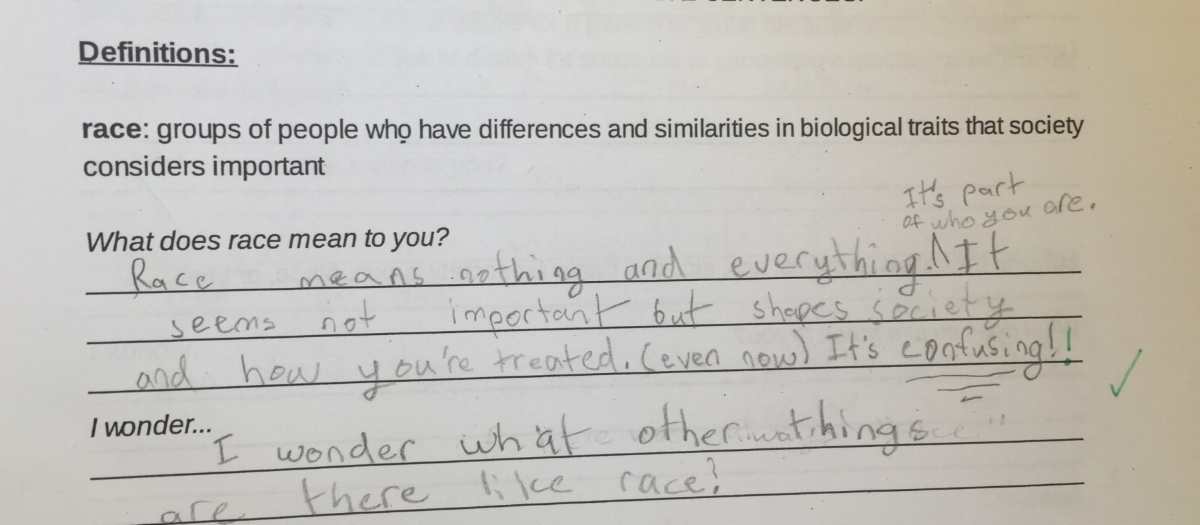After this elated moment of realization, it hits us.. Wow. We are going to the NMAAHC. That is phenomenal AND… How in the world do we prepare fifth graders for such a monumental moment, challenging and remarkable history, and then of course, logistically how many hours can we stretch with 26 ten and eleven year olds in a museum?! The questions, concerns, and backwards planning gears all began cranking at terrifying speeds.
So here we are. Sharing with you some of the first pieces of preparation before we head to the museum on Tuesday (!!).
1. We think together as a class about: why do we learn about history? Why does it matter? We did this before we studied Indigenous People's Day/ Columbus Day and we also did some class thinking around why we celebrate holidays. If you don't have these kinds of thought circles before content-- we highly encourage you to do so. They set the tone for what you are about to embark on and we refer back to these throughout the entire year-- case and point, right now to prepare for this museum!
2. We've already modeled in our classroom that we call time outs and pause for real conversations and learning around race. Just yesterday a student said something that another student found offensive and replied "That's racist!". We paused our lesson as teachers and as a class.. And we talked about it together. Our students already know that conversations about isms (like racism) and identities are not distractions from our learning. They are our learning
3. We work on a definition of racism ahead of time. It is going to come up. They (and many adults) don't actually know what it means. We use the equation:
Racism = prejudice (against a race) + institutional power
It doesn't quite make 'sense' to many of them and very well may not until the end of the year or in ten years. However, we believe in teaching into the complexities of these conversations and cheering students on as we converse and question about all the confusing nuances together. We also believe in being honest with our students and so already in October (yesterday) we got sincere questions like, "These black boys said what is this white girl doing here?' was that racist?" Questions like these are honest and we love to encourage our students to be available for the heavy thinking that comes along with answers that are sometimes (often) quite counter to what they have been taught. The answer to that question was, "Ouch, that doesn't sound like it felt good. No, it was not racist.." And then we talk about WHY!
4. We celebrate and learn from Black excellence all. Of. the. Time! From our This I Believe pieces in which we used Howard White's "The Power of Hello" recording to the many amazing authors we have been using already in our Poetry unit… our students have already seen (and are learning from) phenomenal black thinkers. We hope this has set them to be even more excited about the NMAAHC.
5. We have an overview of SOME* major moments of American history from some black perspectives. We have them go over these (they will by no means take most of them in) so that by the time we get to the museum they at least have a general sense of how history has gone. We also are explicit about the weight of some of the subject matter/imagery and we go back to our earlier conversation about why we value learning about history
*There is a LARGE emphasis on the some because I (Gabby) had a tremendously hard time figuring out exactly what pieces to add into our timeline. I ended up adding poets we have been studying and other authors we know well (Like Jacqueline Woodson) so that this timeline is personalized to our classroom learning. We also, of course, have moments like Emancipation all the way to Michael Brown… This final lesson hasn't happened yet so you might want to stay tuned to see if it goes terribly! It is an clear overload of information and they will not t retain all of it, but we are aiming for it to provide some grounding for students and moments they personally gravitate towards.
6. We do pre-museum homework. In our classroom, one key way we are doing this is by reflecting ahead of time using the 5 W's. Some of these include reflecting on why we are going, why it is important to go, what we are excited about learning etc.. This also includes who will be there and who we might be in this space, along with how we should act. How we should act can include the basic metro safety tips, but can also include identity politics (we love promoting self-awareness!). This also gives us as their teachers a moment to see where different kids are coming from before we take them. We can assess nerves, discomfort, excitement, and so on.
7. We model excitement (because we are!) and we tag some awesome colleagues to join us on this journey. We are grateful they have agreed to weave their way through this museum and experience it with ten and eleven year olds.
8. There's always more but we are leaving you with these. How would you all prepare? What have we missed? How do you prepare for field trips with your students?


























